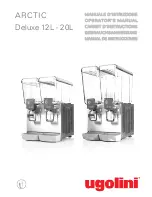
17
Please Remember
– Only use tablet or pellet salt in your softener!
16
User information
User information
HOW YOUR WATER SOFTENER WORKS
When you use water it passes through a vessel
of resin beads inside your water softener. The
resin beads extract the hard minerals making your
water soft. This process is not visible and happens
within the softener. The salt cabinet (see page 3)
is where you load the softener with tablet salt. You
may see 1 or 2 inches of water at the bottom of
the salt cabinet; this is normal, otherwise when the
cabinet is full of tablet salt it will appear dry.
The water softener uses tablet salt for its cleaning
process. The cleaning process fl ushes to drain the
hard minerals that have collected inside the resin
vessel and refreshes the resin beads so they are
ready to make more soft water. This is automatic;
all you need to do is keep the softener topped up
with tablet salt.
TOPPING UP WITH TABLET SALT
Tablet salt is used as the cleansing agent for your
water softener’s resin bed. The salt cabinet will
need to be refi lled. Do not fi ll the salt above the
brinewell cover (see page 14).
IT IS ESSENTIAL THAT APPROXIMATELY 12CM
OF SALT IS MAINTAINED AS A MINIMUM TO
ENSURE OPERATING EFFICIENCY.
Failure to replenish salt will prevent the unit
from cleansing itself on its recharge cycle and
consequently it will be unable to soften water.
Pour the salt slowly into the cabinet. Ensure that
the brinewell cap is secure, as no salt should be
allowed to enter here. DO NOT use granular salt.
ONLY USE TABLET OR PELLET SALT.
Your local water softener stockist will stock salt.
SALT USAGE
Because your automatic demand water softener
uses proportional brining, more frequent recharges
are not at the expense of high salt usage. If you
are a household with low water usage you will
fi nd after a few months that your water softener
will become increasingly effi cient as it adapts to
suit your water usage.
HOLIDAYS
We recommend that you bypass your water
softener if you are away from your home for long
periods of time. See page 8 on how to bypass
your water softener.
CLEANING
Your unit may be cleaned with a damp cloth and
detergent. Do not use bleaches, solvents or spirits
as this may cause damage.
BUILDING A HISTORY
Because it has no historical data to base its
logic on, your water softener will recharge quite
frequently when fi rst used to ensure continuous
softened water. Within a few months it will settle
into a more regular pattern.
LARGE INFLUXES OF GUESTS
If you have people to stay and use more water
than normal you will fi nd that your automatic
demand water softener recharges more frequently.
As your household water usage returns to normal
so too will the recharge frequency.
POWER CUTS
If the electrical power to the water softener is
interrupted, the time display will be blank but the
‘memory’ built into the electronics will keep the
correct time for up to 48 hours.
The water softener will not recharge but will pass
softened water. In the case of a power cut your
demand for water will be less as most appliances
will not work, so a recharge should not be
necessary. When electrical power is returned, one
of two things will happen:
1
Power off up to 48 hours
The display returns and is steady, no operation
is necessary.
2
Power off over 48 hours
The display returns and fl ashes, only the time
requires re-setting. The hardness and recharge
time will not have been lost as they are stored.
Even if the time is incorrect the water softener
will continue to work but will recharge at what
it believes the time to be.
RE-SETTING THE TIME
Re-set the time as described in the programming
section (see page 11).
SHOULD AN ERROR CODE APPEAR
Check electrical connections are as per the
confi guration on page 10.
• Unplug transformer
• Check direct connections
• Replug transformer
• Wait for 6 minutes, if the error is rectifi ed
the error code will not appear
The softener may recharge immediately following
a cleared error code.
Содержание NSC9PRO
Страница 12: ...22 Notes...































